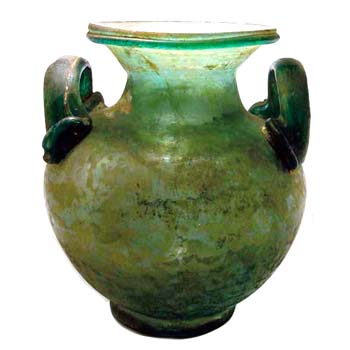Product Description
Archibald Knox / Liberty & Co. Clutha bowl on tri-leg Tudric stand c. 1902


ARCHIBALD KNOX (1864-1933) UK
LIBERTY & CO. London
JAMES COUPER & SONS Glasgow
Clutha bowl on tri-leg stand c. 1902
Clutha glass with inclusions of aventurine streaks and bubbles, polished tri-leg Tudric pewter stand.
Marks: Tudric, 0276
Illustrated: Liberty’s 1875-1975, An Exhibition to mark the Firm’s Centenary (London: Victoria & Albert Museum, 1975), p. 89, number D 250 A; The Designs of Archibald Knox for Liberty & Co., A.J. Tilbrook (London: Ornament Press Ltd., 1976), p. 114; Liberty Style, The Classic Years: 1898-1910, Mervyn Levy (New York: Rizzoli, 1986), p. 31; Archibald Knox, ed. by Stephen A. Martin (London: Academy Editions, 1995), p. 96.
H: 6 3/4″ x Dia: 7 3/4″
Archibald Knox / Liberty & Co. Clutha bowl on tri-leg Tudric stand c. 1902
You must be logged in to post a comment.
ARCHIBALD
EDWARD BARNARD & SONS London, UK
Coffee pot 1903
Sterling silver
Marks: B WMJS RD into a shield (Barnard & Sons), hallmarks, “h” (London Silver hall mark for 1903), 419 (on bottom of pot)
H: 8 3/4″
Price: $19,500
REED & BARTON (active 1824 – present) Taunton, MA
Candlesticks 1928
Sterling silver with Hoffmann-like fluted base and bobêches with undulating stem and palm leaf like terminating detail.
Marks: eagle R (in a shield) lion, Sterling, 1000, cement reinforced, eagle (date mark for 1928).
Model illustrated: Vanity Fair (Dec. 1928, Vol. 31), p. 120., Reed & Barton Vintage Catalog, p. 10, plate number 1000.
For more information on Reed & Barton see: Encyclopedia of American Silver Manufacturers, Dorothy T. Rainwater (West Chester, PA: Schiffer Publishing Ltd., 1986), p. 156-160.
These candlesticks retailed for $19 in 1928.
H: 10″ x Dia: 4 1/2″

Reviews
There are no reviews yet, would you like to submit yours?